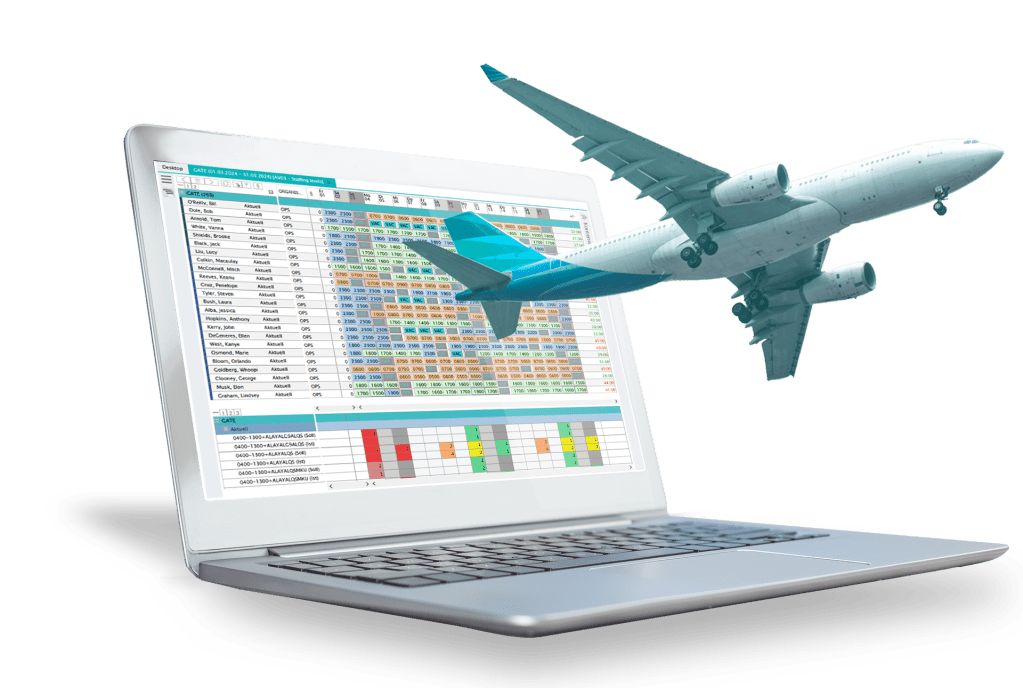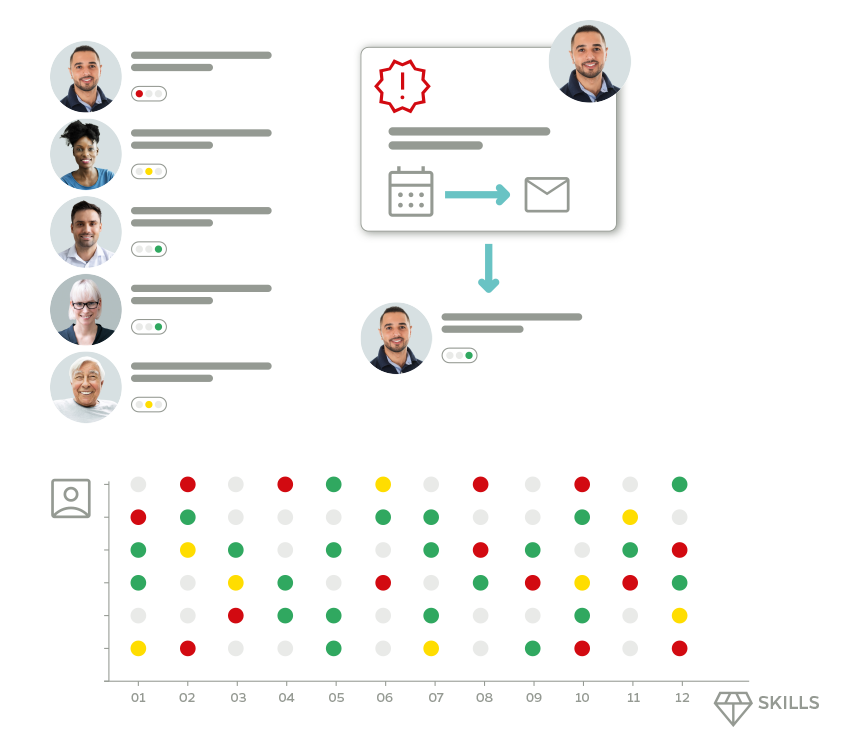How Airports Can Master Peak Season: Efficient Check-In & Boarding with Smart Workforce Management

The holiday season is travel season for many people. While passengers arrive at the airport full of excitement, airport staff face a critical question: How can the increased passenger volume be managed efficiently? How can overcrowded check-in counters and long boarding lines be avoided? Smart planning is essential here.
Modern software solutions offer a key advantage. With the help of Workforce Management (WFM) software, airports can optimize staff planning for check-in and boarding agents even during peak travel times. This technology opens exciting possibilities for streamlining shift scheduling and improving operational efficiency.
Contents
↓ Definition: How is workforce management defined in the context of airport operations?
↓ What needs to be considered when staff planning for check-in and boarding at the airport?
↓ How does Workforce management software support the coordination of check-in and boarding agents?
↓ How does Workforce management software facilitate qualification management when scheduling check-in and boarding staff?
↓ How can airports master the vacation season with the help of forecasting in Workforce management software?
Workforce Management for Airports: Keeping Things Running Smoothly – From Check-In to Takeoff
An airport is like a city that never sleeps – constantly in motion, highly complex in its operations, and critically focused on safety. To make sure every bag ends up on the right flight, security checks run efficiently, and passengers arrive at their gates stress-free, you need more than just dedicated staff. You need smart workforce management.
Definition: How is workforce management defined in the context of airport operations?
Workforce Management (WFM) in the airport environment refers to the intelligent coordination of all personnel resources – from ground staff and baggage handlers to security teams. It ensures that the right employees with the right qualifications are in the right place at the right time. But it goes beyond just creating schedules. It also ensures that certifications are up to date, labor laws and working time regulations are followed, and staffing levels align with actual flight activity and passenger flow.

What needs to be considered when staff planning for check-in and boarding at the airport?
Check-in and boarding are two key processes passengers go through—alongside security screening before their flight. These tasks are often handled by the same employees. For dedicated flights, a check-in counter opens specifically for one flight, and once check-in is complete, the same agent moves to the gate to handle the boarding process.
At shared check-in counters serving multiple flights from the same airline, agents typically remain at the counter and do not switch to boarding duties. In these cases, separate boarding agents rotate between gates, managing the boarding process for multiple flights in sequence. These two different operational setups need to be considered for workforce scheduling.
Qualifications
Different airlines use different booking systems at check-in, and agents must be trained to use the specific system required. This means staff planning must take qualifications into account to ensure that only properly trained agents are assigned to the right counters. Language skills and other qualifications such as gender (e.g. for body search), in cases of special passenger requirements may also be relevant. All necessary qualifications are monitored and considered for the staff planning to meet operational needs and ensure a smooth passenger experience.
Increased Passenger Volume
During peak travel seasons in Summer, passenger volumes rise significantly leading to greater staffing needs at check-in counters and boarding gates. At the same time, employees understandably want to take time off to enjoy their own holidays. Smart staff planning is essential to balance this demand: ensuring sufficient coverage while ensuring fair vacation scheduling. By avoiding agent overload and dissatisfaction, airports can maintain or even improve service quality. Well-balanced planning plays a critical role in delivering a smooth and positive passenger experience.
How Does WFM Software Help Coordinate Check-In and Boarding Agents?
Workforce Management (WFM) software provides powerful support in coordinating check-in and boarding agents by giving planners a clear, real-time overview of all staff and staffing needs. At the push of a button, the system calculates which employees should be scheduled where and when to meet operational demand as efficiently as possible. This precise scheduling helps avoid both overtime and idle time – reducing stress for agents and improving customer service quality.
The software considers existing overtime or underworked hours and allows employees to submit their preferred shifts. In the event of unexpected changes such as flight cancellations or staff absences – schedules can be adjusted quickly and flexibly. Updates are sent instantly via app, so agents are always in the right place at the right time, even in high-pressure situations.
Even when staff frequently rotate positions within the airport or switch between tasks such as during single flight check-ins – the system ensures smooth operations. It also automatically complies with labor laws, internal agreements, and union contracts, further enhancing efficiency and employee satisfaction.
Learn more about our shift scheduling app here: https://plano-wfm.com/en/myplano-employee-self-service-ess/
How does WFM software facilitate qualification management when scheduling check-in and boarding staff?
WFM software significantly streamlines qualification management for check-in and boarding agents. It provides a clear, centralized overview of each employee’s skills and certifications, enabling planners to assign staff based on the specific requirements of each flight such as knowledge of certain booking systems or other relevant qualifications.
The system also alerts managers in advance of upcoming certification expirations, allowing time to schedule renewals. If a certification is set to expire, the agent will only be scheduled for the corresponding tasks until that date and only reassigned once the renewal is complete. This proactive approach prevents staffing gaps in certification-dependent roles and ensures that every scheduled agent meets the necessary skill and compliance standards.

Learn more about skill management here: https://plano-wfm.com/en/skill-management-software/
How can airports master the vacation season with the help of forecasting in WFM software?
Peak travel seasons present a major challenge for airports: accurately forecasting and planning staffing needs in advance. This is where WFM software’s forecasting capabilities come into the field. By analyzing a wide range of historical data, the software can predict future staffing requirements. This is especially critical during holiday periods, when passenger volumes deviate significantly from the norm and understaffing can quickly trigger operational breakdowns across the airport.
The software uses complex algorithms based on historical trends and operational data to determine exactly how many employees, with which qualifications, are needed—when and where. It factors in elements such as weather forecasts, flight routes, passenger behavior (e.g., online check-in rates), and expected baggage check-ins.
A particularly valuable feature is the use of forecasting profiles, which help calculate process durations for different scenarios. For example, check-in profiles account for variations in passenger behavior – first-time travelers may need more time at the counter, while some short-haul flights may require no check-in at all. Arrival profiles, on the other hand, analyze patterns such as leisure travelers arriving early with baggage, versus business travelers arriving closer to departure. All these variables are built into customizable profiles within the forecasting engine, allowing staffing needs for check-in and boarding to be anticipated with high precision. No matter how much passenger volume and staffing demands fluctuate by day or hour, WFM software ensures that the right number of qualified employees are in the right place at the right time.
Conclusion
The benefits of using WFM software for staff planning check-in and boarding staff are essential to ensuring smooth airport operations. Features like forecasting and qualification management make it easier for workforce planners to schedule shifts effectively while staying prepared for the unpredictable nature of each day.
The software promotes fairness in scheduling by even distributing less desirable shifts and allowing employee shift preferences to be considered. As a result, staff feel valued and motivated – leading to more empathetic interactions with passengers. Everyone benefits: employees, managers, and travelers alike. Ultimately, implementing WFM software contributes to a more efficient, balanced, and positive working environment at the airport—and leaves passengers with better overall experience.
Would you like to find out more?
Further information about our workforce management software and the areas of application can be found here:
→ Workforce Management from plano
Archive
Work-Life Balance
We’re Here for You
